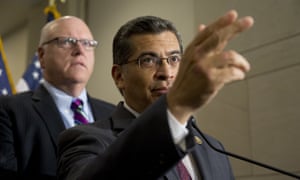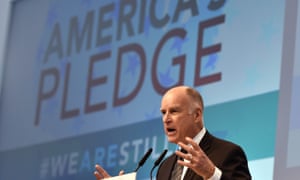Extract from The Guardian
Before they became Trump’s nemesis, California’s empowered Democrats acted as wing support to the Obama administration
The
era in American politics dominated by Donald Trump truly began in
November 2008 with the election of Barack Obama. Obama’s historic
victory generated Republican fear of an extinction event through
demographic change and a younger, more diverse Democratic coalition with
the potential to hold a durable popular majority. The Trump phenomenon
was in large part a reaction to that perceived threat. Even after the
shock of Trump’s victory, a massive resistance formed first in marches,
and in grass roots organizing, and then in the efforts of progressive
states. Who’s leading the pack? Undoubtedly, California.
California has long operated as a laboratory for progressive causes: Before they became Trump’s nemesis, California’s empowered Democrats acted as wing support to the Obama administration, testing out strategies too bold for the harsh constraints that Obama faced in DC, where a Republican Congress fought him at every turn.
And what a giant laboratory it is!
"After helping Obama, leading the resistance against Trump was the natural next step"
California is practically a country unto itself, with a GDP now
greater than the UK, and the 5th largest in the world. With nearly 40
million people, California contains one out of eight Americans.California has long operated as a laboratory for progressive causes: Before they became Trump’s nemesis, California’s empowered Democrats acted as wing support to the Obama administration, testing out strategies too bold for the harsh constraints that Obama faced in DC, where a Republican Congress fought him at every turn.
And what a giant laboratory it is!
"After helping Obama, leading the resistance against Trump was the natural next step"
The issues that animated politics in the Obama-Trump era were precisely those that most impacted California. Los Angeles and Orange counties are home to nearly 10% of the country’s more than 11 million undocumented residents. Five percent of all Medicaid recipients live in LA County. With its glorious coastline, the state has resisted offshore oil drilling and has been at the center of the struggle to tighten fuel standards on cars.
After helping Obama, leading the resistance against Trump was the natural next step. The state moved quickly to defend the very policies it had initiated in the Obama era: tightening automobile fuel standards beyond federal requirements, protecting the rights of undocumented residents, and expanding Medicaid beyond the federal minimum against Trump’s moves to roll back fuel standards, eliminate the Affordable Care Act, and remove protections for immigrants and refugees.
When Trump pulled out of the Paris climate accords, Governor Jerry Brown and other political leaders went overseas to keep the flame alive, acting almost as its own nation-state. Attorney General Xavier Becerra filed multiple lawsuits against Trump actions. California passed a sanctuary law that prevented local law enforcement from assisting federal immigration authorities in the emerging deportation strategy of the Trump administration.

The nationalization of politics in the Obama-Trump era brought California Democrats onto the national stage, first quietly for Obama and then loudly against Trump. Before, California was not much of a force in national Democratic politics, except as a place to raise campaign money. The state’s national pull was all on the Republican side, nurturing the presidential ambitions of Richard Nixon and Ronald Reagan. The California primary came so late in the year that the state’s millions of Democratic voters were shut out (now rectified by the state’s move to a March primary).
In this massive state, California’s Democrats have two bases: San Francisco and Los Angeles.
The best organized and most powerful Democratic locale has long been San Francisco. Former governor Pat Brown built the modern California Democratic party here in the 1950s. The legendary assembly speaker Willie Brown did the same in his era. Today, leading Democrats call San Francisco their political home, including Speaker Nancy Pelosi, Senator Dianne Feinstein, top tier presidential candidate Senator Kamala Harris, and the new governor, Gavin Newsom. Newsom has already shown that he will be even more aggressive than Jerry Brown in confronting the Trump administration by announcing that he will withdraw the state’s National Guard from most of the border enforcement duties that Brown had, with some limitations, agreed to provide.
"California’s Republicans, once competitive here, are heading downhill at a fast clip"
But Southern California, long derided for low participation and a disengaged political culture, is slowly coming into its own. One out of four Californians lives in LA County, where the issues of immigration and health care are life and death. The Southland has generated a popular LA mayor and potential presidential candidate Eric Garcetti, newly crowned House committee chairs Adam Schiff (Intelligence) and Maxine Waters (Banking); and the powerful speaker of the assembly, Anthony Rendon. Ironically, it was the high turnout shift to Democrats in hitherto sleepy Southern California counties that flipped seven of the 23 House seats Democrats needed nationally to put Nancy Pelosi into the speaker’s chair, where she demonstrated the power of her San Francisco political skills in her confrontations with Donald Trump.
The new Democratic governor and his massive majority in the legislature may have all the power in the world, but they also have an immense responsibility. If the Democratic party today may be the most popular and effective progressive party in western democracies (perhaps not a high bar) California represents its apogee. Much rests on what it does with its power. If California Democrats make good policy in health care, immigration and other areas, they will help define the Democratic presidential campaign in 2020; if they fall short, or design poorly, they will damage their party’s prospects. Will California’s next performance be role model or cautionary tale?
- Raphael J Sonenshein, is a political scientist and executive director of the Pat Brown Institute for Public Affairs at Cal State LA

No comments:
Post a Comment